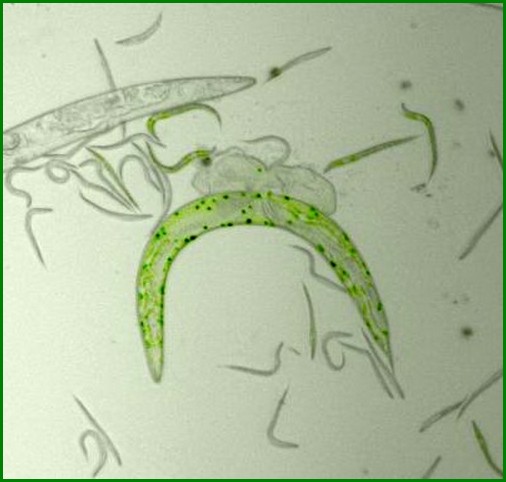For personal and population about the benefits of individual and population benefits is speculate, because compromise is somewhere ... therebetween.

Two versions of the nematode C. elegans, used in the experimental verification of the hypothesis of harmful and beneficial alleles. (Photo by Ivo Chelo / Instituto Gulbenkian de Ciencia.)
More than 90 years ago, the famous British biologist JBS Haldane suggested that the individual benefit and harm of mutations may not be very different from each other at the level of the general population - and this, in particular, indicated that the fate of the new allele (gene variant) can not be predicted, and even increasing the chances of an individual to survive and leave offspring, in most cases, it may simply disappear from the population. This theory was included in population genetics, research on the adaptation of species to new conditions, based on such behavior alleles. However, no experimental evidence that hitherto were not.
Such an experiment has succeeded in placing scientists from the Institute Gulbenkian Foundation (Portugal). Ivo Chelo and his colleagues used the nematode Caenorhabditis elegans, which is, first, breed predominantly self-fertilization, that is the fate of a particular allele in certain conditions it is very easy to follow, and secondly, it multiplies very quickly, which allows us to trace the fate of the allele For several generations.
For a start, researchers collected specimens from the same favorable or unfavorable mutation (with a favorable or unfavorable variant allele) and two or five of them ran into a population of normal worms. As expected, the more advanced exerted individuals in the population, the smaller the likelihood of extinction favorable allele. And for harmful mutation probability of scrubbing of the population was, of course, higher.
However, this does not mean that a favorable mutation in the population had the undisputed advantage and became dominant: As the researchers write in Nature Communications, for generations less fit individuals in the population with a high frequency, and it was the higher, the smaller the population. That is, in the first phase of its appearance auspicious sign and were unfavorable to some extent, are equal, as predicted by the theory of Haldane's plus for the population may be indistinguishable from the minus. That is, at the sign of auspiciousness is unchallenged, and with it most individuals survive and thrive, but the ease of this should not be a mandatory fixing of such a trait in the population - as well as from disadvantaged should not be mandatory washout feature, at least in the initial stages of its formation .
The researchers then tried to estimate the probability that a favorable sign to get all the individuals in the population. To do this, they repeated the experiment with the initial invasion allele, but the second time the number of nematodes thrown into the box with a welcome sign was already much higher - as if a favorable sign is entrenched in the population. And here it was found that the fate of the allele, whether favorable or unfavorable, depending on its frequency.
If the frequency is greater than 5%, it was perceived as malicious population and washed out. If, however, its frequency was below 5%, the allele was regarded as useful. And it does not depend on how it was at the level of the individual harmed or benefited him.
That is, the genetic diversity of the population appeared as a dynamic system in which it was impossible to accurately predict the fate of a particular allele, and even more so it was impossible to count on the fact that a particular allele will capture the entire population. Most likely, says Ivo Chelo, the relationship between individuals and the environment is so diverse that it is impossible for the individual use of mutations to judge its benefits for the whole population, especially for generations.
Why this is so, researchers have yet to find out as they only experimentally confirmed the well-known hypothesis of population biology. Also, do not forget that the experiments were carried out on the self-fertilizing worms, that is, the exchange of alleles and their combination with the other during sexual process was not considered in the study.
in the wake of the Gulbenkian Institute, Shutterstock, compulenta.computerra.ru
Home Births Understood - Environment and labour/delivery
Cafe Scientifique - Home Birth Understood: Tales & Truths
Which birth settings are available in Canada, in BC? Is home birth safe? Why do some physicians and midwives disagree about home birth safety? What birth settings offer the best safety, comfort, and birth experience for women? Why?
This Cafe will explore current evidence about home birth safety, potential advantages and disadvantages of home birth on individual and population levels, and barriers to and societal perceptions of home birth in Canada. The speakers will invite participants to examine the evidence, the politics, and public discourse surrounding birth place.
Speakers:
Dr. Patricia Janssen
Associate Professor, Director Master of Public Health Program in the School of Population and Public Health
University of British Columbia
Dr. Karen Buhler
Head of Department of Family Practice
B.C. Women's Hospital
Dr. Brenda Wagner
Obstetrician and Medical Director for Fraser Health and Regional Physician Planning Leader, Vancouver Coastal Health
Moderator:
Saraswathi Vedam
Director of Midwifery
University of British Columbia